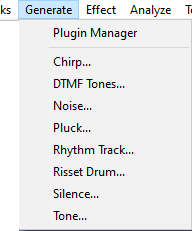Generate Menu
| For generators that you use often you can use Keyboard Preferences to set up keyboard shortcuts for those Generators. You can also set up a custom shortcut for Repeat Last Generator. |
Plugin Manager
Selecting this option from the Generate Menu (or the Effect Menu or Analyze Menu) takes you to a dialog which enables you to load and unload Generators (and Effects and Analyzers) from Audacity. This enables you to customize your Generate Menu making it shorter or longer as required. For details see Plugin Manager.
See also this https://plugins.audacityteam.org/nyquist-plugins/generator-plugins set of available Nyquist generator plugins] on the Audacity Support site, that you can easily download and add to Audacity.
Backing up or transferring settings
To see how to backup your settings, last used and any user presets you have saved using the button in each generator's dialog, see this page.
Using Audacity's Generators
- Generate audio into a new track: If there are no existing tracks, choose the required generator. If there are existing tracks, click outside the tracks (in the gray background) to deselect them, then Generate.
- Insert generated audio at the cursor position: Place the cursor in the track then Generate. The specified duration of audio will be inserted into the selected track(s) at the cursor position. The total length of the selected track(s) will therefore be increased.
- Replace an existing selection with generated audio: Select the region then Generate. The selected region(s) will be replaced with the generated audio. The total length of the selected track(s) will remain the same, unless you change the length in the generator to replace the selection with a longer or shorter one.
Amplitude
All built-in generators (except of course Silence) let you type an amplitude value for the loudness of the generated audio. Permitted values are between 0 (silence) and 1 (the maximum possible volume without clipping), with a default of 0.8.
Duration
Type (or use the keyboard arrows) to enter the required Duration. If the first digit you want is highlighted, just type the whole number. If the required first digit is not highlighted, use Left or Right arrow on your keyboard to move to the first digit, then type. You can also increment a highlighted digit with keyboard Up or Down arrow instead of typing.
- When generating at the cursor, Duration initializes to 30.000 seconds (except for the DTMF generator which defaults to 1.000 second). However, your last entered Duration is always remembered.
- When replacing a selection region, Duration always displays the exact duration of that selection to the nearest audio sample.
- When using a generator in a macro, the macro must first create the selection to generate into. Any changes you make to the Duration when editing the macro step parameters will be ignored.
Selection Format for Duration
Whether generating in a selection or not, you can change the Selection Format to another unit of Duration so that the generation will be in those units. To do this, open the context menu by clicking the triangle to right of the digits. You can also open the menu by hovering over or selecting in the Duration digits, then right-clicking or using a keyboard equivalent.
Built-in Generators
Chirp
Chirp produces four different types of tones like the Tone Generator but additionally allows setting of the start and end amplitude and frequency. Short tones can be made to sound very much like a bird-call. As with Tone, frequencies can be specified anywhere between 1 Hz and half the current Project Sample Rate as shown in Audio Settings Preferences.
DTMF Tones
Generates dual-tone multi-frequency (DTMF) tones like those produced by the keypad on telephones. For each tone you wish to generate, enter numbers from 0 to 9, lower case letters from a to z, and the * and # characters. You can also enter the four "priority" tones used by the US Military (upper case A, B, C and D).
Noise
Generates one of three different types of noise. White noise is that which has the greatest ability to mask other sounds, as it has similar energy at all frequency levels. Pink noise and Brownian noise both have more energy at lower frequencies, especially Brownian, which has the most muffled, low pitched sound of the three types. By their nature, pink and Brownian noise may have a few peaks not exactly at the requested amplitude if the tracks are only a few seconds long.
Silence
Generates audio of zero amplitude, the only configurable setting being duration. When applied to an audio selection, the result is identical to .
Tone
Generates one of five different tone waveforms:
- Sine,
- Square,
- Sawtooth and
- Square (no alias)
- Triangle
The name of each tone roughly describes its appearance when zoomed in sufficiently to see each cycle of the waveform.
Nyquist Generators
Audacity includes the following Nyquist generators.
| Nyquist generators do not usually take the length of selected audio as the length of the audio to be generated. Instead, specify the length required in the appropriate input field(s) of the plugin. Any selected audio will be replaced by the length of audio specified in the plugin, thus the total length of the track(s) will change unless the selected and specified lengths are identical. |
Pluck
A synthesized pluck tone with abrupt or gradual fade-out, and selectable pitch corresponding to a MIDI note.
Rhythm Track
Generates a track with regularly spaced sounds at a specified tempo and number of beats per measure (bar). It can be used like a metronome for setting a steady beat against which an overdub recording can be made.
Risset Drum
Produces a realistic drum sound consisting of a sine wave ring-modulated by narrow band noise, an enharmonic tone and a relatively strong sine wave at the fundamental.
